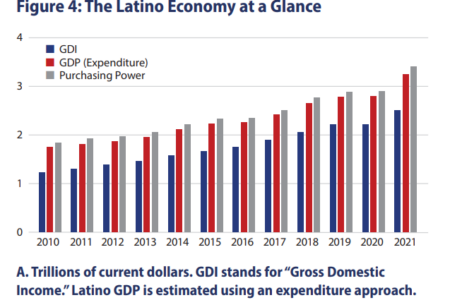
Share On Social!
The total economic output, or gross domestic product (GDP), for Latinos in the United States has grown from $1.7 trillion in 2010 to $3.2 trillion in 2021, according to the Latino Donor Collaborative’s 2023 U.S. Latino GDP Report.
Let’s dive deeper into why and how Latinos are driving the U.S. economy.
The Latino GDP
The U.S. Latino GDP is $3.2 trillion.
That makes it the is the fifth-largest economy in the world embedded inside the United States, according to 2023 U.S. Latino GPD Report.
“U.S. Latinos are not a niche market, nor small, nor as sometimes described as a market of the future,” according to the report. “It is already the third fastest growing economy on the planet, and may soon rival China’s growth rates.”
Growth of the Latino GDP
The Latino GDP continues to rise.
It went from $1.7 trillion in 2010 to $2.1 trillion in 2017 and $2.8 trillion in 2020.

“The growth trajectory of the Latino economy is remarkable,” said Sol Trujillo, leader of the Latino Donor Collaborative. “Over the past decade, Latino annualized income growth has outpaced non-Latinos by a significant margin, with a 4.7% increase compared to 1.9%.”
“This pattern is not limited to income growth; Latino consumption and purchasing power have been growing 2.1x to 2.4x faster than non-Latinos.”
The growth of the Latino GDP is also mirrored in state economies.
Significant Latino economies exist in California, Texas, and Florida (among other states), amounting to $682 billion, $465 billion, and $240 billion, respectively.
“The California Latino economy alone would rank as the 21st largest in the world, nestled between Poland and Switzerland,” according to the Latino GDP report.
The report also highlights the largest industrial components of the U.S. Latino economy:
- Public Administration, accounting for $438.8 billion (15.6%) of value added in 2021.
- Manufacturing: $288.0 billion
- Real Estate and Rental and Leasing: $278.6 billion
- Healthcare and Social Assistance: $238.7 billion
- Wholesale Trade: $232.6 billion
“This broad industry spread demonstrates the Latino economy’s [varied] nature,” according to the GDP report.
Reasons for Latino GDP Growth: Rising Population
The Latino population in the United States has risen to 19.1%, up from 18.5% in 2020.
With that population growth, also came economic growth.
Data from the report shows that Latino income growth extends beyond low and middle-income wage earners.
A review of high-income earners (those in the 95th percentile and above) shows the average annual growth rate among Latino high earners to be “approximately 10 times greater “than that of non-Latinos.
U.S. households identifying as Latino has also risen from 11.6% in 2010 to 14.4% in 2021.
“Data on consumer spending reveals that Latino households typically allocate more funds toward rent compared to other demographic groups,” according to the GDP report. “Despite lower homeownership rates among Latinos, the growth rate of home acquisition within this group is noticeably faster.”
Reasons for Latino GDP Growth: Workforce Participation
The Latino influence in the workforce has also grown and, ultimately, bolstered the economy.
“The younger age of Latinos, paired with their significant population growth, results in this group comprising nearly all new additions to the 18-to-64 age bracket cohort,” the report said.
In turn, as older non-Latino workers retire, younger Latinos are stepping into the labor market, contributing tax revenue and boosting spending.
“Latinos above the age of 16 have consistently shown a higher propensity to join the labor force, a trend that persists,” according to the GDP report.
The Latino GDP Report also found that the share of Latino wage and salary income as reported in American Community Survey statistics has risen sharply over the past decade.
“The share has risen from just over 10.3% of total U.S. income to 13.3%—a 29% rise in share,” according to the report.
The report highlights that this growth on an average annual basis, demonstrating that inflation-adjusted incomes of the Latino community have grown twice as fast as those of non-Latinos between 2011 and 2021.
Reasons for Latino GDP Growth: Education Attainment
The GDP report also noted Latino educational attainment as an important factor in economic influence, with numbers continuing to grow.
In fact, the number of Latino individuals holding a bachelor’s degree or higher increased by 6.8% on an annualized basis between 2011 and 2021.
Similarly, a previous report showed that Latinas have experienced a 52% rise in college degree attainment at Hispanic-Serving Institutions (HSIs) from 2015 to 2020.
The total number of Latinos with advanced degrees, however, remains below the national mean,” the report said. “Thus, there is still significant upside in terms of increased productivity.”
“This combination of robust population growth, high labor force participation, and increasing human capital will continue to drive the dynamic growth witnessed so far,” according to the GDP report.
Exploring the Health of Your Community
Given the impact of Latinos to the US economy, the health of Latinos is critical.
Find out what health improvement looks like in your community. Download the Salud America! Health Report Card to auto-generate local, Latino-driven data and maps on a variety of health-related topics including education, health care, housing, transportation, and more.
Compare your local results to the rest of your state and the nation.
Use the information from the Report Card to start conversations about health differences in your area.
Share the results with local leaders, health departments, or organizations to speak up for change in your community.
By The Numbers
23.7
percent
of Latino children are living in poverty



